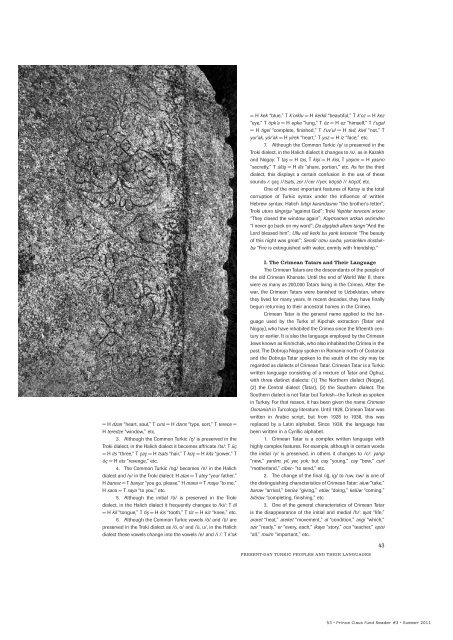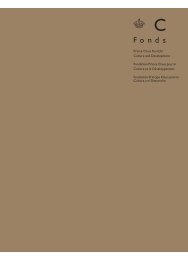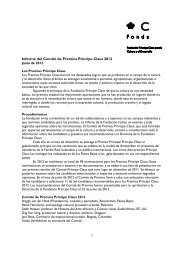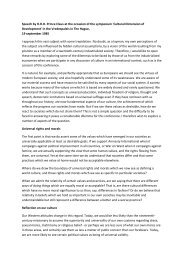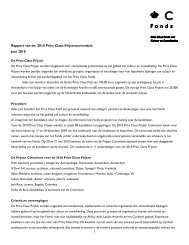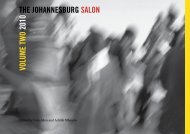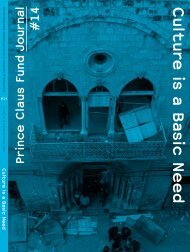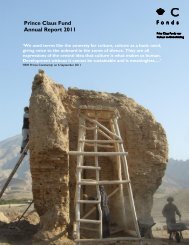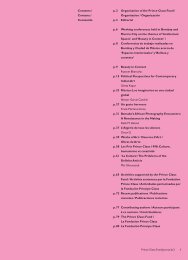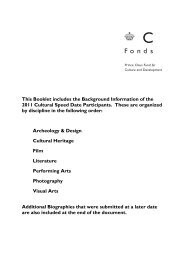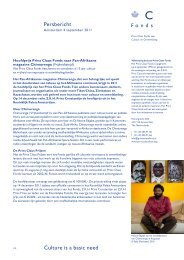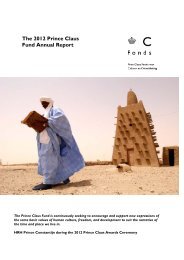030–053talattekin_alt:turklergaram 29.11.2007 9:21 Uhr Seite 421. In Kumuk, the initial palatal /k/ changes to /g/: käç-> geç-, ke:çä > geçe “evening,” käl- > gel-, kertü > gerti “true,right,” ke:t- > get- “to go,” ke:tär- > geter- “to remove,” kötür-> götür- “to lift,” kişi > gişi, etc.2. In Kumuk, vowel rounding takes place in severalwords as a result of following labial consonants: ağzımız >awzubuz, awçı > awçu “hunter,” bağımız > bawubuz, kamış >kamuş, birlän > bulan “with,” yapış- > yabuş-, etc.3. The initial postvelar /q/ changes to guttural fricative/x/: qonşı > xonşu “neighbor,” kum > xum “sand,” qu:rt > xurt“wolf,” etc.4. The initial /ä/ is narrowed to /i/: ädär- > iyer- “to follow,”äg- > iy-, “to bend,” ädlä- > iyle- “to wet,” ärü- > iri- “tomelt,” etc.5. The /r/ sound at the end of the plural suffix disappearsbefore the genetive-accusative suffix -nı/-ni and thedative suffix -ga/-ge: giççiler “little ones,” but giççile-ni “littleones’,” ullular “adults,” but ullula-nı “adults’,” balalar “children,”but balala-ğa “to the children,” üyler “houses,” but üyle-ge “tothe houses,” etc.6. A vowel is created at the end of words of Arabic originthat end in a pair of consonants alien to the Turkic language:Arabic asl > aslu “basic, main,” Ar. fikr > fikru “idea,” Ar.ilm > ilmu “science,” Ar. waqt > wakti “time”; but Ar. sabr >sabur “patience,” etc.A few sentences in Kumuk: Awrumaygan başnı yawlıkbulan baylamas “They do not treat anyone who isn’t ill”; İssiliğolay güçlü çü, hatta adam suwdan çıkmağa süymey “It is so hotthat nobody wants to come out of the water”; Yer Günnüaylanasından aylana “The earth goes around the sun”; Onuki tüzbolmak neden görüne dağı? “How is it obvious that he is right?”Cıyın tünegün boldu “The meeting was held yesterday”; Sütteawzu bişgen suwuk suwnu üfürüp içer “He who scalds his mouthwith hot milk will blow on cold water before drinking.”G. The Karachay-Balkars and Their LanguageThe Karachays and Balkars (or Malkars) are two Turkishpeoples with very similar dialects. The Karachays live mainly inthe Autonomous Karachay-Circassian province linked to theRussian Federation, while the Balkars (or Malkars) live in theAutonomous Kabardin-Balkar Republic. There are also smallKarachay and Balkar communities in Kirghizstan, Kazakhstan,and Uzbekistan. According to the 1989 census, the total numberof Karachays and Balkars in the former Soviet Unionamounted to 156,140 and 88,771, respectively. There are alsosmall Karachay communities in Turkey.Written forms of Karachay and Balkar emerged followingthe Soviet revolution. From 1920 to 1924, the Karachays andBalkars employed an Arabic alphabet, and from 1924 to 1936they used a Latin alphabet. Since 1936, they have employed aCyrillic alphabet.The Karachay-Balkar dialects can be divided into threegroups: (1) The Karachay-Baksan-Chegem dialect, (2) theMalkar (Balkar) dialect, (3) the Holaml›-B›z›ng›l› dialect.The Karachay written language is based on theKarachay-Baksan-Chegem dialect. The characteristic featuresof the Karachay-Balkar written language are common to theKipchak group of languages: the change of the initial /a€/ into42LANGUAGE AND IDENTITY/aw/ (bağ > baw “vineyard,” tağ > taw “mountain,” etc.); thechange of the final /a€u/ into /ow/ (buzağu > buzow “calf,”kırağu > kırow “frost,” etc.); the change of the final /ägü/ into/ew/ (bilägü > bilew “grindstone,” küdägü > küyew “groom,”etc.); and the change of /o€, u€, ow/ into /uw/ (boğ- > buw-,tuğ- > tuw- “to be born,” kow- > kuw- “to repel,” soğık > suwuk“cold,” etc.).1. As for the distinguishing features of Karachay-Balkar,the most important is the disappearance of the /r/ at the endof the plural suffix: tağlar > tawla “mountains,” yigitler > cigitle“youths.” The final /r/ at the end of the copula -dır/-dir disappears:aman “bad,” aman-dı “(it is) bad,” aşxı “good,” aşxı-dı “(itis) good,” etc.2. Another feature of Karachay-Balkar is the use of thesuffix -lık/-lik, -rık/-rik in forming the future tense: bar-lık-ma “Iwill go,” min-nik-me “I will ride,” aşa-rık-sa “You will eat,” etc.3. One of the most important features of Karachay-Balkar is the change of /aw, awu/ to /uw/ or /uwu/: aw > uw“hunt,” awçı > uwçu “hunter,” awuç > uwuç “palm,” etc.Similarly, /ög, üg/ change to /üy/ or /ü/: ögrän- > üren-, ögrät-> üret-, ügür > üyür “family,” tügüm > tüyüm “knot,” etc.A few sentences in Karachay-Balkar: Ahmat elge deribardı “Ahmet went to the village”; Sabiyle tamadalarını aytxanlarınatınggılay edile “The children listened to what their elderswere telling them”; Ol kanatlını uçup barganlay atadı “He hits thebird in flight”; Men kesimi cangılganımı angılayma “I realize Imade a mistake”; Anı caşawu alkın allındadı “He has his wholelife in front of him.”H. The Karaim and Their LanguageThe Karays, or Karaim (Karaim is the plural of the Hebrewword Karay, employed in the Torah to refer to “a reader of theHoly Book”), are members of an Old Turkic community whowere converted to Judaism during the Khazar period.Until quite recently, the Karaim lived as small communitiesin Lithuania in the cities of Trakai (Troki) and Panevé_ys,and in Ukraine in the cities of Lutsk and Halicz (Halich). In formertimes, there were also Karaim communities near the cityof Evpatoria on the Crimean Peninsula. According to the 1959census, the total number of Karaim living in the former SovietUnion was 5,900; by the time of the 1989 census, the numberhad fallen to 2,803. Before 1930, the Karaim employed theHebrew, Latin, and Cyrillic alphabets in writing their language,but most of the old manuscripts of religious texts (translations)are, naturally, in the Hebrew script.Karay, which is now a dead language, had three dialects:(1) Troki (Trakai), (2) Halich-Lutsk, and (3) Crimean. TheCrimean dialect of Karay was once assimilated by CrimeanTatar. The Troki and Halich-Lutsk dialects are now totally assimilatedby the Slav languages. There are several important differencesbetween the Troki and Halich dialects of Karay:1. Although in the Halich dialect the back explosive /k/is generally preserved, in the Troki dialect it changes to fricative/x/: Halich arık = Troki arıx “tired,” H aksak = T axsax, Hkasık = T kaşux “spoon,” H yabuk = T yabux “closed,” H yırak =T yırax “far,” etc.2. Similarly, although /c/ is preserved in the Trokidialect, in the Halich dialect it changes to affricate /dz/: T canYenisei inscriptions,sixth century. MinusinskMuseum, Minusinsk,Russia.<strong>Prince</strong> <strong>Claus</strong> <strong>Fund</strong> Reader #1 · Summer <strong>2011</strong> · 52
030–053talattekin_alt:turklergaram 29.11.2007 9:21 Uhr Seite 43= H kek “blue,” T k’orklu = H kerkli “beautiful,” T k’oz = H kez“eye,” T öpk’a = H epke “lung,” T öz = H ez “himself,” T t’ugal= H tigel “complete, finished,” T t’uv’ul = H tivil, kivil “not,” Tyur’ak, yür’ak = H yirek “heart,” T yuz = H iz “face,” etc.7. Although the Common Turkic /fl/ is preserved in theTroki dialect, in the Halich dialect it changes to /s/, as in Kazakhand Nogay: T taş = H tas, T kişi = H kisi, T yaşırın = H yasırın“secretly,” T ülüş = H ilis “share, portion,” etc. As for the thirddialect, this displays a certain confusion in the use of thesesounds r: çaç //tsats, zer //cer //yer, köçüb // köçüf, etc.One of the most important features of Karay is the totalcorruption of Turkic syntax under the influence of writtenHebrew syntax: Halich bitigi karandasnın “the brother’s letter”;Troki uturu tängriga “against God”; Troki Yaptılar tereceni artxarı“They closed the window again”; Kaytmamen artkarı sezimden“I never go back on my word”; Da algışladı allarnı tangrı “And theLord blessed him”; Ullu edi kerki bu yarık ketsenin “The beautyof this night was great”; Sendir otnu suvba, yamanlıknı dostlukba“Fire is extinguished with water, enmity with friendship.”= H dzan “heart, soul,” T cıns = H dzıns “type, sort,” T terece =H teredze “window,” etc.3. Although the Common Turkic /ç/ is preserved in theTroki dialect, in the Halich dialect it becomes affricate /ts/: T üç= H its “three,” T çaç = H tsats “hair,” T küç = H kits “power,” Töç = H ets “revenge,” etc.4. The Common Turkic /ng/ becomes /n/ in the Halichdialect and /y/ in the Troki dialect: H atan = T atey “your father,”H barınız = T barıyız “you go, please,” H mana = T maya “to me,”H sana = T saya “to you,” etc.5. Although the initial /ti/ is preserved in the Trokidialect, in the Halich dialect it frequently changes to /ki/: T til= H kil “tongue,” T tiş = H kis “tooth,” T tiz = H kiz “knee,” etc.6. Although the Common Turkic vowels /ö/ and /ü/ arepreserved in the Troki dialect as /ö, o/ and /ü, u/, in the Halichdialect these vowels change into the vowels /e/ and /i /: T k’okI. The Crimean Tatars and Their LanguageThe Crimean Tatars are the descendants of the people ofthe old Crimean Khanate. Until the end of World War II, therewere as many as 200,000 Tatars living in the Crimea. After thewar, the Crimean Tatars were banished to Uzbekistan, wherethey lived for many years. In recent decades, they have finallybegun returning to their ancestral homes in the Crimea.Crimean Tatar is the general name applied to the languageused by the Turks of Kipchak extraction (Tatar andNogay), who have inhabited the Crimea since the fifteenth centuryor earlier. It is also the language employed by the CrimeanJews known as K›r›mchak, who also inhabited the Crimea in thepast. The Dobruja Nogay spoken in Romania north of Costanzaand the Dobruja Tatar spoken to the south of the city may beregarded as dialects of Crimean Tatar. Crimean Tatar is a Turkicwritten language consisting of a mixture of Tatar and Oghuz,with three distinct dialects: (1) The Northern dialect (Nogay),(2) the Central dialect (Tatar), (3) the Southern dialect. TheSouthern dialect is not Tatar but Turkish—the Turkish as spokenin Turkey. For that reason, it has been given the name CrimeanOsmanish in Turcology literature. Until 1928, Crimean Tatar waswritten in Arabic script, but from 1928 to 1938, this wasreplaced by a Latin alphabet. Since 1938, the language hasbeen written in a Cyrillic alphabet.1. Crimean Tatar is a complex written language withhighly complex features. For example, although in certain wordsthe initial /y/ is preserved, in others it changes to /c/: yangı“new,” yardım, yıl, yer, yok; but caş “young,” cay “bow,” curt“motherland,” ciber- “to send,” etc.2. The change of the final /i€, ig/ to /uw, üw/ is one ofthe distinguishing characteristics of Crimean Tatar: aluw “take,”baruw “arrival,” berüw “giving,” etüw “doing,” kelüw “coming,”bitirüw “completing, finishing,” etc.3. One of the general characteristics of Crimean Tataris the disappearance of the initial and medial /h/: ayat “life,”araret “heat,” areket “movement,” al “condition,” angi “which,”azır “ready,” er “every, each,” ikaye “story,” oca “teacher,” episi“all,” muim “important,” etc.PRESENT-DAY TURKIC PEOPLES AND THEIR LANGUAGES4353 · <strong>Prince</strong> <strong>Claus</strong> <strong>Fund</strong> Reader #3 · Summer <strong>2011</strong>


